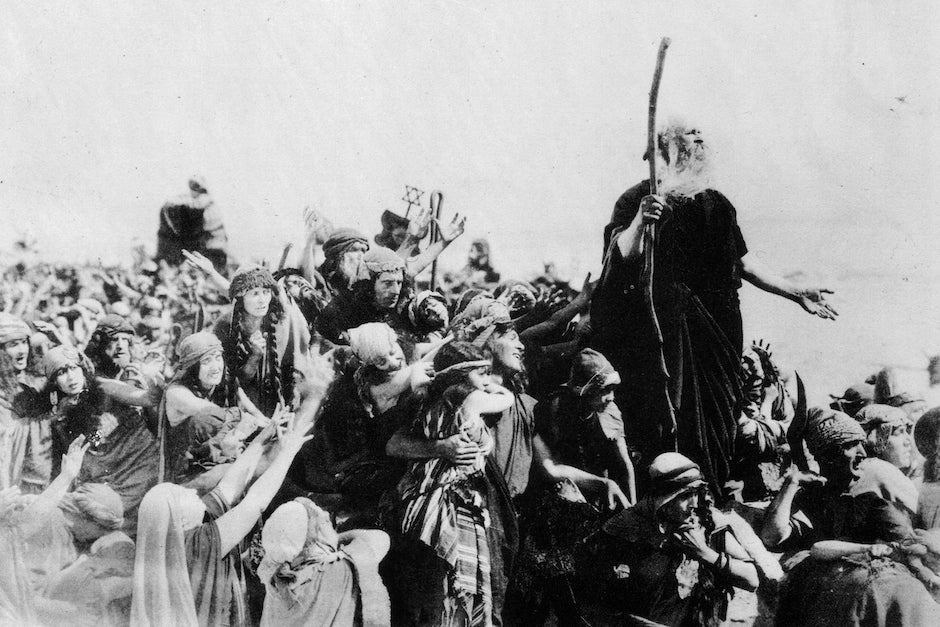A century ago, saying that there was a silent film screening downtown would be like saying “There’s something on television” today. There were numerous theaters within blocks of the New Haven Green, from grand entertainment palaces to tiny rooms where the loudest noise was not a piano accompanist but the whirr of the projector mounted right behind the audience.
Even though you could say New Haven has been experiencing a renaissance of silent movie screenings, they’re still few and far between—three or four a year compared with dozens a day in the 1920s and ’30s. Back then, silent movies were the most popular of popular entertainments, edging out vaudeville revues in the days before network radio and TV, not to mention talking films, engaged our senses.
At 7 p.m. this Friday, Trinity Church on the Green transforms its elegant environs into an old-fashioned movie palace, showing the 1923 epic The Ten Commandments (screen-capped above) with live, improvised organ accompaniment from Boston-based silent film specialist Peter Krasinski.
Trinity Church’s famous Aeolian-Skinner organ was built in 1935, by which time the silent movie era had been mostly over for some time. The “talkie” which transformed the film industry, The Jazz Singer (starring Broadway star Al Jolson, several of whose live shows played at the Shubert on College Street), was released in 1927. But it wouldn’t have been unusual to find silent films still being shown in downtown New Haven well after the dawn of talking pictures. Some of the local theaters had fine organs which they continued to use for pre-show entertainments and intermission sing-alongs. It would have been unusual to see a popular film in a church, but hearing organ melodies wafting down Chapel Street would have been a common occurrence.
sponsored by
Today, it’s more common to hear silent-movie music than it’s been in a long while. Much of New Haven’s renewed interest in seeing silent films in public is due to Lyric Hall in Westville. Having restored and reclaimed a stage area in the building which dates back to 1912, Lyric Hall presents all kinds of shows, but regularly acknowledges the original purpose of the theater space by screening silent movies with live musical accompaniment. In 2011, Steve Asetta formed the 10-piece Lyric Hall Theater Orchestra, which has done a handful of concerts a year, accompanying films as diverse as the murder mystery The Cat and the Canary, the horror film Nosferatu and comedies from the likes of Charlie Chaplin and Buster Keaton.
Nosferatu (an unauthorized 1922 German Expressionistic classic based on the 1897 Bram Stoker novel Dracula) has also proven popular with modern musical types. The neoclassical ensembles Loop 2.4.3 and SoundUnderground conspired a few years ago to present a post-modern musical take on Nosferatu at the Neighborhood Music School on Audubon Street. That’s just a block away from the recently renovated Little Theatre, now a stage run by the Educational Center for the Arts but originally built in 1924 to be the major silent movie house in that part of town.
In 2003, the experimental jazz combo Goose Lane (featuring several players who’d end up in the Lyric Hall Theater Orchestra) scored the silent horror flick The Unknown, featuring Lon Chaney. In the past few years, the local symphony Orchestra New England, best known for its recreations of Colonial-era classical concerts at United Church on the Green, has moved into the industrial age for an annual “Silent Movie Gala” in the Co-op Arts & Humanities High School auditorium accompanying films by the likes of D.W. Griffith and—there’s that name again—Buster Keaton. Keaton’s work is beloved of film-scorers due to its comic rhythms and inventive camera work.
In the realm of silent film revivals, Lon Chaney shines almost as brightly as Keaton. The Unknown’s star—dubbed “Man of 1,000 Faces” due to his dexterity with makeup—was seen in cape and ghoulish white pallor, his nostrils stretched and his eyes popping, when Trinity Church projected The Phantom of the Opera onto a screen at the front of the church back in February 2013, with nationally known church organist Tom Trenney.
Trinity’s associate music director Andy Kotylo notes, “It’s a chance to show off the organ at Trinity.” Kotylo says he only knows of two venues in Connecticut with old-fashioned theater organs of the type which used to routinely accompany film screenings, and one of those instruments is in private hands. “Church organs are not really meant to do this kind of thing, but can be made to sound like a theater organ.”
Trinity Church has considered making its silent movie concerts an annual rather than biannual—as in, once every two years—event, but “we held off,” Kotylo says, because of the dual difficulties of finding films which could reliably draw hundreds of people into the church and finding enough skilled organists to accompany them. “You can’t just call down the street and get someone to play,” he says, smiling.
The Phantom of the Opera, accompanied by organist Tom Trenney
Trinity Church on the Green, corner of Temple and Chapel streets, New Haven (map)
Friday, February 1 at 7 p.m.
(203) 776-2616
www.trinitynewhaven.org
Written by Christopher Arnott. The original version of this updated story was published on January 30, 2013.









